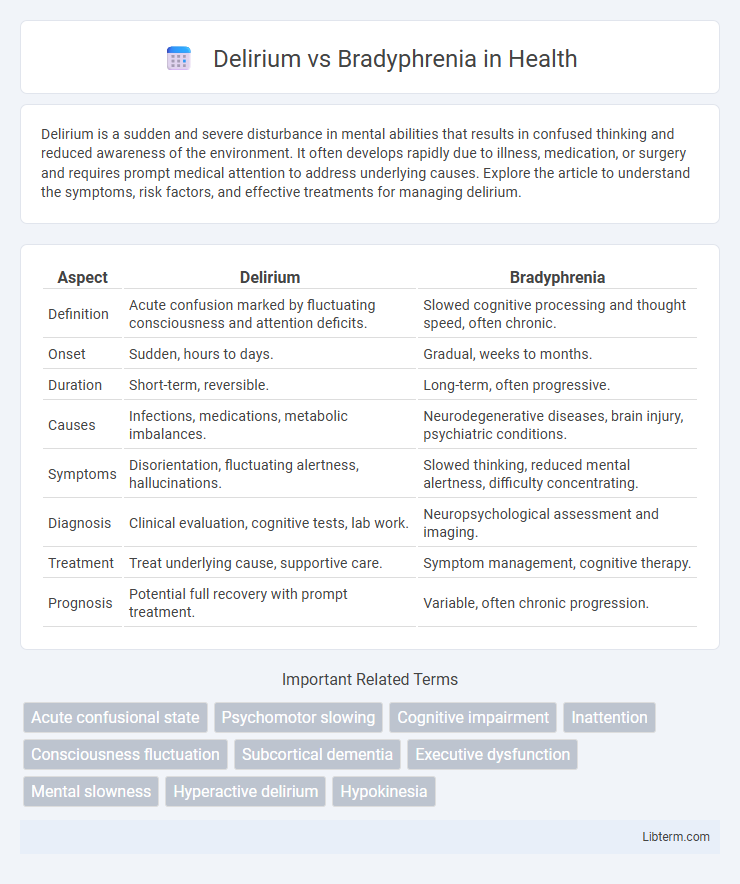Delirium is a sudden and severe disturbance in mental abilities that results in confused thinking and reduced awareness of the environment. It often develops rapidly due to illness, medication, or surgery and requires prompt medical attention to address underlying causes. Explore the article to understand the symptoms, risk factors, and effective treatments for managing delirium.
Table of Comparison
| Aspect | Delirium | Bradyphrenia |
|---|---|---|
| Definition | Acute confusion marked by fluctuating consciousness and attention deficits. | Slowed cognitive processing and thought speed, often chronic. |
| Onset | Sudden, hours to days. | Gradual, weeks to months. |
| Duration | Short-term, reversible. | Long-term, often progressive. |
| Causes | Infections, medications, metabolic imbalances. | Neurodegenerative diseases, brain injury, psychiatric conditions. |
| Symptoms | Disorientation, fluctuating alertness, hallucinations. | Slowed thinking, reduced mental alertness, difficulty concentrating. |
| Diagnosis | Clinical evaluation, cognitive tests, lab work. | Neuropsychological assessment and imaging. |
| Treatment | Treat underlying cause, supportive care. | Symptom management, cognitive therapy. |
| Prognosis | Potential full recovery with prompt treatment. | Variable, often chronic progression. |
Understanding Delirium: Key Features and Causes
Delirium is an acute neuropsychiatric syndrome characterized by sudden onset, fluctuating attention, and impaired cognition, often caused by infections, metabolic imbalances, or drug toxicity. It contrasts with bradyphrenia, which involves a gradual slowing of thought processes without acute onset or fluctuating consciousness. Understanding delirium's distinct features is essential for timely diagnosis and treatment, as it can indicate reversible underlying medical conditions.
What is Bradyphrenia? Definition and Etiology
Bradyphrenia is characterized by an abnormal slowness of cognitive processing affecting thought, speech, and motor responses, commonly observed in neurodegenerative diseases such as Parkinson's disease and Alzheimer's disease. The etiology of bradyphrenia involves disruptions in dopaminergic pathways, particularly in the basal ganglia and frontal cortex, leading to impaired neural transmission and slowed mental activity. Unlike delirium, which is an acute and fluctuating cognitive disturbance, bradyphrenia presents as a chronic, progressive slowing of mental functions.
Delirium vs Bradyphrenia: Core Differences
Delirium presents as an acute, fluctuating disturbance in attention and awareness often caused by an underlying medical condition, whereas bradyphrenia refers to a chronic slowing of thought processes commonly associated with neurodegenerative diseases like Parkinson's disease. Delirium typically involves rapid onset and fluctuating symptoms including confusion and disorientation, while bradyphrenia manifests as subtle, progressive cognitive slowing without acute fluctuations. Recognizing these core differences is crucial for accurate diagnosis and effective management strategies in clinical practice.
Clinical Manifestations: Delirium Compared to Bradyphrenia
Delirium presents with acute onset of fluctuating disturbances in attention, awareness, and cognition, often accompanied by hallucinations, agitation, and disorganized thinking. Bradyphrenia is characterized by a gradual slowing of thought processes and reduced cognitive speed without the acute confusion or perceptual disturbances seen in delirium. Clinical manifestations of delirium include rapid changes in mental status and impaired consciousness, whereas bradyphrenia typically involves steady cognitive decline without marked fluctuations or altered consciousness.
Diagnosis: Recognizing Delirium and Bradyphrenia
Delirium diagnosis relies on identifying acute onset, fluctuating attention, and altered consciousness using tools like the Confusion Assessment Method (CAM). Bradyphrenia, characterized by slowed cognitive processing, is diagnosed through detailed neuropsychological testing assessing processing speed and executive function. Differentiating the two involves evaluating symptom onset, duration, and cognitive profiles to guide appropriate treatment strategies.
Underlying Mechanisms: Pathophysiology of Both Conditions
Delirium results from acute disturbances in neurotransmitter systems, particularly cholinergic deficiency and dopaminergic excess, causing widespread cortical dysfunction and altered neural connectivity. Bradyphrenia involves slowed cognitive processing linked to frontal-subcortical circuit impairment, commonly associated with neurodegenerative diseases like Parkinson's disease and progressive supranuclear palsy. Both conditions exhibit distinct pathophysiological mechanisms: delirium reflects transient metabolic and inflammatory disruptions, whereas bradyphrenia stems from chronic structural and neurochemical degeneration.
Risk Factors: Who is Susceptible to Delirium or Bradyphrenia?
Delirium predominantly affects elderly patients, especially those with pre-existing cognitive impairments, severe illness, or metabolic imbalances, while bradyphrenia is commonly observed in individuals with neurological disorders such as Parkinson's disease or dementia. Hospitalization, polypharmacy, sensory deficits, and infections increase susceptibility to delirium, whereas bradyphrenia risk factors include neurodegenerative conditions and chronic brain injuries. Understanding these distinct risk profiles aids in early identification and targeted intervention for affected populations.
Treatment Approaches for Delirium vs Bradyphrenia
Treatment approaches for delirium primarily focus on identifying and addressing the underlying cause, such as infections, medication side effects, or metabolic imbalances, alongside supportive care and environmental modifications to reduce sensory overload. Bradyphrenia, often associated with neurodegenerative conditions like Parkinson's disease or dementia, requires a management strategy centered on dopaminergic medications and cognitive rehabilitation to improve processing speed and executive function. Both conditions benefit from multidisciplinary care involving neurologists, psychiatrists, and rehabilitation specialists for optimal outcomes.
Prognosis and Long-term Outcomes
Delirium often has a fluctuating course with potential full recovery if the underlying cause is promptly treated, but delayed intervention can lead to persistent cognitive decline or increased mortality. Bradyphrenia, typically associated with chronic neurological conditions such as Parkinson's disease or dementia, manifests as a progressive slowing of thought processes with poorer long-term cognitive prognosis and limited reversibility. Long-term outcomes in delirium depend largely on early diagnosis and management, whereas bradyphrenia reflects ongoing neurodegenerative pathology with gradual worsening over time.
Prevention and Management Strategies for Cognitive Dysfunction
Preventing delirium and bradyphrenia involves early identification of risk factors such as infection, medication side effects, and metabolic imbalances, alongside timely interventions to maintain hydration, nutrition, and sleep hygiene. Management strategies emphasize pharmacologic treatments tailored to underlying causes, cognitive stimulation, and environmental modifications that reduce sensory overload and promote orientation. Rehabilitation programs and caregiver education further support recovery and reduce the incidence of recurrent cognitive dysfunction episodes.
Delirium Infographic

 libterm.com
libterm.com